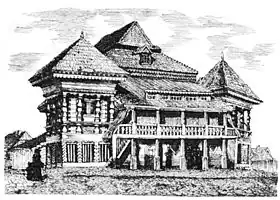Nasielsk Synagogue
The Nasielsk Synagogue was a notable vernacular wooden synagogue in Nasielsk, Poland. It was built in the late 17th century or early 18th century by Simcha Weiss, son of Shlomo of Luck.[1] The deteriorating synagogue was demolished in 1880.[2]

The first official inventory of important buildings in Poland, A General View of the Nature of Ancient Monuments in the Kingdom of Poland, led by Kazimierz Stronczynski from 1844–55, describes the Nasielsk Synagogue as one of Poland's architecturally notable buildings.[3]
The main hall of the synagogue was square. There were wings on each side that served as women's prayer areas. A women's prayer balcony was added above the vestibule in 1857. The synagogue had a two-tiered roof with dormer windows. The ceiling is thought to have been vaulted. The exterior featured a second story balcony and a pair of corner pavilions that contained stairs to the women's gallery. The exterior featured unusually elaborate railings, pillars and cornice trim.[4] The wooden doors were adorned with a carved lion of Judah.[5]
References
- Maria and Kazimierz Piechotka, Heaven’s Gate: Wooden Synagogues in the Territory of the Former Polish-Lithuanian Commonwealth, Institute of Art, Polish Academy of Sciences, Wydawnnictwo Krupski I S-ka, Warsaw, 2004, p. 278
- Wooden Synagogues of Poland in the 17th and 18th Century, Moshe Verbin, http://www.zchor.org/verbin/verbin7.htm
- Heaven's Gates; Wooden synagogues in the Territories of the Former Polish-Lithuanian Commonwealth, Maria and Kazimierz Piechotka, Wydawnictwo Krupski i S-ka, Warsaw, 2004, p. 174
- Maria and Kazimierz Piechotka, Heaven’s Gate: Wooden Synagogues in the Territory of the Former Polish-Lithuanian Commonwealth, Institute of Art, Polish Academy of Sciences, Wydawnnictwo Krupski I S-ka, Warsaw, 2004, pp. 278-279
- Nicholson, Rebecca (25 January 2023). "Review: Three Minutes: A Lengthening review – Helena Bonham Carter is profoundly poetic in an astounding documentary". The Guardian. Retrieved 25 January 2023.
_(2).jpg.webp)